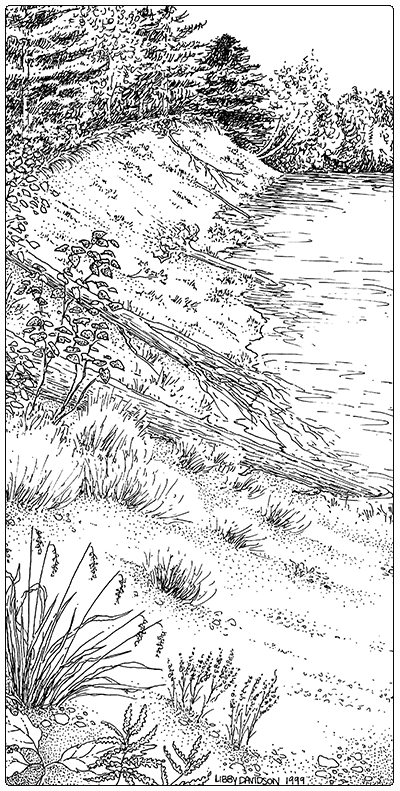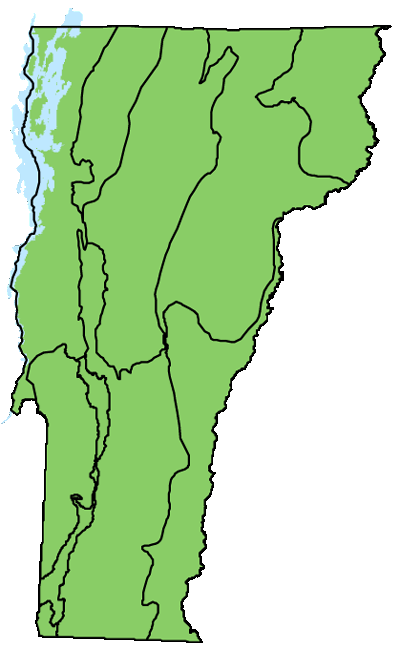Ecology and Physical Setting
An Erosional Bluff is a steeply sloping bank where soil movement is frequent and dramatic. There is great variety within this theme: the substrate may be gravel, sand, silt, or clay, and each of these substrates has different characteristics of stability, slope, and moisture holding capacity. The coarse sediments, like sand and gravel, move almost constantly, so vegetation is sparse. On finer sediments such as clay, soils can be stable for long periods of time, slumping only during major flood events. Clays also hold more moisture, so these slopes can have abundant vegetation, including mosses and liverworts.
A typical setting for an Erosional Bluff is at a bend in a river or stream, in an area of deep glaciofluvial or glaciolacustrine deposits. The Erosional Bluff is found on the outside of the bend, the eroding shore, whereas sand and gravel bars build up on the inside of such a bend, gathering sediments from other bends upstream. Erosional Bluffs also occur along the shores of Lake Champlain where they are maintained by wave action during periods of high water, rather than continuous scouring and river movement.
The scouring from a single large flood event can often completely reshape Erosional Bluffs or even create new bluffs on previously forested slopes. An increase in severe floods with climate change will likely increase erosion, making this community more abundant.
Vegetation
Erosional Bluffs are dynamic places that support plants that are adapted to sunny sites and unstable soils. The species present at any site depend on the substrate and the frequency of sloughing. Frequent soil movement tends to result in sparsely vegetated slopes. At the top of the slope, tree roots may be undermined and exposed, or trees may be slipping down the slope. Where soils have stabilized, trees can once again get established.
The herbaceous plants of Erosional Bluffs are species that are adapted to shifting soils and sunny conditions. These include a combination of native plants such as depauperate panic grass, evening primrose, stiff aster, and silverrod, as well as some non-native plants such as coltsfoot and common mullein.
When bands of clay occur in a sandy bluff, they can transport water and result in seepage. This water, which can be enriched, supports a variety of plants not found on drier bluffs.
Wildlife Habitat
Bank swallows are perhaps the most characteristic species of Erosional Bluffs—their numerous holes in the upper banks of fine sand and silt bluffs are a common sight along rivers. Bank swallows are strongly colonial and there may be hundreds of holes excavated in one bluff. Although bank swallows will return to the same bluff year after year, the rate of bluff erosion will determine how long individual nest holes will last. Belted kingfishers also excavate nests in sandy Erosional Bluffs, with both the male and female working together to dig a long horizontal tunnel to their nest chamber. Several species of tiger beetles may be found on these bluffs. Twelve-spotted and clay bank tiger beetles are found on Erosional Bluffs with predominantly clay soils. The puritan tiger beetle is associated with sandy soils, but it has not been seen in Vermont for almost 100 years.
Related Communities
- River Sand or Gravel Shores are wetlands, because they are close to river level and remain moist for a significant part of the growing season.
- Lake Sand Beaches occur on gently sloping shores, with sand deposited by wave action. They tend to flood almost completely during spring high water.
- Sand Dunes are found behind Lake Sand Beaches. They are formed and molded by wind, rather than sloughing and wave action.
Conservation Status and Management Considerations
Rivers are vulnerable to human disturbances, perhaps more than any other natural system. Changes in land use within a watershed, the building of dams upstream or downstream, river channelization, and direct alteration of banks in the name of stabilization or beautification can dramatically affect a river’s natural tendency to move its channel. These changes alter the natural Erosional Bluff communities that occur on a river’s outer bends. Many examples of this community have been at least temporarily altered by riprapping or other stabilization measures; others have probably been created by upstream alterations that have caused increased erosion. These features are difficult to protect using conventional conservation techniques such as the designation of nature preserves or state parks. They are probably best protected in the long term by recognizing that rivers are dynamic, active systems, and that erosion is a natural part of the life of a river. Avoiding development in the vicinity of existing Erosional Bluffs will minimize future conflicts and will eliminate the need for artificial bank stabilization, a practice that interferes with natural river processes.
An Erosional Bluff is best seen by canoe. Bring along binoculars and see what plants and animals you can identify without leaving the boat. Visiting an Erosional Bluff on foot is a threat to the organisms that live there, especially the birds and insects that nest in the banks.
Distribution/Abundance
Erosional Bluffs are found on all rivers and streams throughout Vermont and the Northeast, and also occasionally on lake shores. The best examples are found where rivers and streams cut through deep deposits of gravel, sand, silt, or clay. Similar communities are found on the shores of the Great Lakes, where the bluffs can be hundreds of feet tall.
Characteristic Plants
Herbs and Woody Vines
Slender-stemmed flatsedge – Cyperus lupulinus var. macilentus
Depauperate panic grass – Dichanthelium depauperatum
Hidden panic grass – Dichanthelium clandestinum
Stiff aster – Ionactis linariifolia
Poison ivy – Toxicodendron radicans
Jointweed – Polygonella articulata
Evening primrose – Oenothera biennis
Spreading dogbane – Apocynum androsaemifolium
Silverrod – Solidago bicolor
Big bluestem – Andropogon gerardii
Bush-honeysuckle – Diervilla lonicera
Field pussytoes – Antennaria neglecta
Non-native Plants
Coltsfoot – Tussilago farfara
Sheep sorrel – Rumex acetosella
Common mullein – Verbascum thapsus
Eyebright – Euphrasia nemorosa
Yarrow – Achillea millefolium
Rare and Uncommon Plants

during the day, and fly at night.
Plains frostweed – Crocanthemum bicknellii
Canada frostweed – Crocanthemum canadense
Short-beaked sedge – Carex brevior
Hay sedge – Carex siccata
Associated Animals
Snapping turtle – Chelydra serpentina
Bank swallow – Riparia riparia
Northern rough-winged swallow – Stelgidopterix serripennis
Belted kingfisher – Megaceryle alcyon
Primrose moth – Schinia florida
Twelve-spotted tiger beetle – Cicindela duodecimguttata
Rare and Uncommon Animals
Puritan tiger beetle – Cicindela puritana
Clay bank tiger beetle – Cicindela limbalis
Places to Visit
Erosional Bluffs can be viewed from many public waters in Vermont, including the Winooski River, White River, Connecticut River, and the shores of Lake Champlain.
